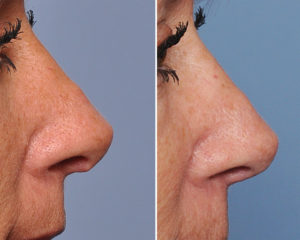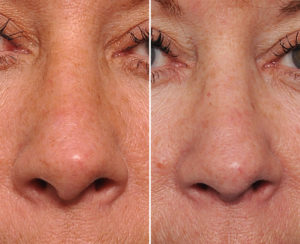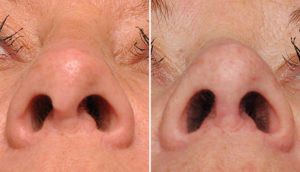Background: The columella is the strip of skin and cartilage between the nostrils. It provides a smooth connection between the tip of the nose and the upper lip. Its shape is controlled by the cartilages which run within the skin as well as the septum behind it. A ‘good’ columella is really one that does not stand out in any way and sits obscurely at the bottom of the nose. A ‘bad’ columella is one that is noticeable either because it is deviated or sticks out too far.
The hanging columella is when it extends down to far, creating exaggerated columellar show. This is most noticeable in the profile view where too much of it is seen and sits too far below the rim of the nostrils. It can occur as a natural result of nasal growth with a long septum that pushes it too far forward. The medial footplate cartilages that compose it can also be too long or wide.
The hanging columella can also result from a prior rhinoplasty where the medial footplate cartilages have been overly weakened, making them prone to bending or notching. (and a columellar strut has not been used) Conversely it can also be caused by a columellar strut graft that has become or was placed too far forward.
Case Study: This 52nyear-old female presented with a columellar protrusion that had developed from an open rhinoplasty several years before. She felt it look like something was hanging out of her nose all the time.


Highlights:
1) A hanging columella can occur from either natural nasal growth or from a prior rhinoplasty.
2) The hanging or protrusive columella that results from a prior rhinoplasty usually causes a columellar deviation and notching.
3) The revision rhinoplasty columellar correction removes the excessive medial footplate cartilage and straightens and stabilizes it with sutures.
Dr. Barry Eppley
Indianapolis, Indiana



